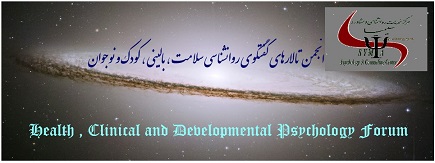دور معیوب اضطراب
ترس و اضطراب شدید از کجا می آیند و چگونه از دست خارج می شوند
ترسی که نیاکان ما با دیدن یک ببر دندان شمشیری تجربه می کردند یا ترسی که ما امروزه در مواجهه با خودرویی که به سمت ما می آید ، تجربه می کنیم ، بسیار منطقی است. در حقیقت ، این ترس برای ما حیاتی و پراهمیت است ، زیرا ترس می تواند نشانه ای از یک خطر واقعی باشد و ما هم نیاز داریم که به این ترس منطقی واکنش نشان دهیم. ولی وقتی که ترس در شرایطی ایجاد می شود که تهدیدی وجود ندارد و بصورت نگرانی اغراق آمیز و شدید بروز می یابد ، اهمیت دارد که بفهمیم چنین ترس و اضطراب مخربی چگونه ساخته شده است. در چنین شرایطی اضطراب در یک چرخه معیوب قرار می گیرد:
محرک های فعال ساز درونی یا بیرونی
یک واقعه ، موقعیت یا فکر می تواند اضطراب پیچیده ای ایجاد کند. بعنوان مثال ، فکر کردن به یک آزمون پیش رو می تواند یک محرک درونی باشد. چیزهایی نظیر یک سگ بزرگ ، یا شرایط ناآشنا (یک مهمانی ، گروه درمانی ، شغل جدید) نمونه هایی از محرک های بیرونی اضطراب زا باشند.
1- درک یک فعال ساز
راه اندازهایی نظیر فکر کردن به یک آزمون پیش رو (= راه انداز درونی) یا وجود یک غریبه در یک گروه (=محرک بیرونی)
2- ارزیابی یک فعال ساز
ادراک و برداشت منفی ما از یک فعال ساز با افکار نگران کننده همراه می شوند . بعنوان مثال "آیا می توانم انجامش دهم" یا نمی دانم چطور انجامش دهم . همه فکر می کنند که من عجیب و غریب هستم."
3- احساس ترس و اضطراب
افکار منفی اضطراب را فعال می کنند و اضطراب سبب ایجاد عدم اطمینان و ناراحتی می شود.
4- تغییرات جسمانی:
احساس ترس و اضطراب سبب بروز علایم جسمانی نظیر تپش قلب ، تهوع ، لرزش یا تعریق می شود.
سپس ما این نشانه ها را ترس آور ادراک می کنیم. یعنی احساس می کنیم که واقعاً در خطر هستیم. ما نشانه های جسمانی را دلایلی بر وجود تهدید تفسیر کرده و سپس چرخه ی معبوبی شروع می شود و ادامه می یابد (ادراک --- ارزیابی --- احساس --- تغییرات جسمانی)
همچنین رفتار اجتنابی این چرخه را تشدید می کند: بسیاری از انسان ها برای کاهش اضطراب از موقعیت ها یا اعمالی که اضطراب زا هستند اجتناب می کنند. بعنوان مثال ممکن است دعوت به یک مهمانی را نپذیرید تا با غریبه ها حرف نزنید . ممکن است با اجتناب کردن بطور موقت و کوتاه مدت از اضطراب رها شوید ولی در بلندمدت و در مواجهه با شرایط مشکل ساز رفتار اجتناب سبب تشدید اضطراب می شود. یعنی اجتناب تجربه مثبت در اختیار ما قرار نمی دهد و راه حلی در هنگام بروز اضطراب به ما نشان نمی دهد.
مهم است که این چرخه معیوب را بشناسیم و گام های هدفمندی برای شکستن این چرخه برداریم تا بتوانیم ترس و اضطراب خویش را کنترل کنیم. شما می توانید تمرین هایی را در بخش اضطراب این برنامه انتخاب کنید و این تمرین ها برای شما مفید خواهند بود.
The vicious cycle of anxiety Where excessive fear and anxiety come from and how they can get out of hand
The instant fear our ancestors felt when they saw a saber-toothed tiger, or the fear we feel today when a car is rushing toward us, is very reasonable. In fact, it’s critical to our survival, because fear can signal a real danger that we need to react to. But when it comes to exaggerated fears in situations that are not immediately threatening, it’s important to understand how this kind of “dysfunctional” fear and anxiety builds upon itself. When this happens, anxiety escalates in a vicious cycle:
Triggers – internal or external stimuli:
An event, situation, or thought can set anxiety spiraling. For instance, thinking of an upcoming test could be an internal stimulus. Things like a big dog, or an event where you encounter lots of strangers (a party, a therapy group, starting a new job), could represent external stimuli.
1. Perceiving a trigger:
The triggers, such as thoughts of the upcoming test (= internal trigger) or the presence of strangers in the group (= external trigger), are noticed.
2. Evaluating the trigger:
The trigger is perceived negatively, accompanied by worried thoughts like “I can’t do it,” or “I don’t know how to act. Everyone will think I’m weird.”
3. Feelings of fear and anxiety:
The negative thoughts trigger feelings of anxiety and fear, which in turn generate uncertainty and unease.
4. Physical changes:
Feelings of anxiety and fear often cause bodily symptoms, like racing heartbeat, nausea, trembling, or increased sweating.
We then perceive these signs as fear signals. That is, we feel that they confirm that we really are in danger. We interpret the physical symptoms as evidence of a threat, and then the same cycle starts all over again (perception => evaluation => feeling => physical changes).
There is also avoidant behavior, which exacerbates this vicious cycle: To reduce their anxiety, many people avoid situations or actions that could trigger anxiety. Examples of this might include turning down an invitation to a birthday party so that you don’t have to talk to any strangers or avoiding certain modes of transportation. There may be short-term relief and the anxiety may subside but, in the long term, in the absence of any new (corrective) experiences with the problem situation, the avoidant behavior causes your anxiety to grow and grow. That means you don’t have any positive experiences of how the situation can go well and be manageable.
It is important to recognize this vicious cycle and take purposeful steps to break through it and manage your fears and anxieties.


